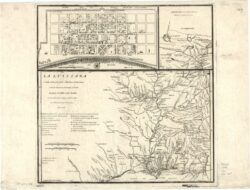Treaty of Fontainebleau
The Treaty of Fontainebleau shifted ownership of western Louisiana and New Orleans from France to Spain during the French and Indian War.
This entry is 6th Grade level View Full Entry

Library of Congress, Geography and Map Division
A map of the territory of Louisiana and New Orleans ceded by France to Spain during the Treaty of Fontainebleau.
What caused the French and Indian War, and where was it fought?
The French and Indian War is also sometimes called the Seven Years War. It was the first war between European empires that began in colonies and spread to Europe. The war began as a conflict between Great Britain and France over territory in North America. Different groups of both Native peoples and Europeans took sides, and the conflict grew until fighting took place in North America, the Caribbean, West Africa, Europe, and Asia.
After the British conquered French territory in Canada in 1760, France asked Spain for military and financial help. In August 1761 the two kingdoms formed an alliance. During alliance negotiations the French negotiator tried to use colonial Louisiana as a bargaining chip. He hoped that the offer of Louisiana would persuade Spain to provide France with a large loan, enter the war immediately, or both. Spain showed interest in Louisiana but did not yet agree.
How did Louisiana and New Orleans become part of peace negotiations?
Several developments in 1762 made Louisiana a more valuable bargaining chip. In January Great Britain declared war on Spain. Within a few months France lost several islands they held in the Caribbean, including Martinique, Guadeloupe, and St. Lucia. Because these sugar-producing islands generated more wealth than Louisiana, France was willing to give up a piece of the Louisiana territory to the British for the return of these Caribbean lands. France began negotiating peace terms with Britain, agreeing to give up the portion of Louisiana east of the Mississippi to Great Britain. The British would keep Canada while France would regain the Caribbean islands. Although New Orleans is located on the east side of the river, the French negotiator managed to keep it out of British hands by assuring them that there was alternative access to the Gulf of Mexico above the city through Lake Pontchartrain and Lake Maurepas.
The Spanish opposed France giving up territory that would allow the British to control the coast along the Gulf of Mexico. Spain became even less willing to negotiate a peace settlement when news of the capture of Havana (the capital of one of their colonies in the Caribbean) reached Europe. To persuade Spain to end the war, France offered its ally western Louisiana and New Orleans. The Spanish agreed, believing the territory would provide a buffer zone between the British colonies and Mexico’s mineral wealth.
Both the Treaty of Fontainebleau and a draft of the Treaty of Paris were signed on the same day at a French palace called Château de Fontainebleau on November 3, 1762. Representatives of Great Britain, France, and Spain formally approved the final version of the Treaty of Paris on February 10, 1763.
When and how did Spain take control of colonial Louisiana?
Terms of the Treaty of Fontainebleau were not made public until 1764. Louisianans did not know they would be subject to Spanish rule until late spring of that year, and the first Spanish governor, Antonio de Ulloa, did not arrive in New Orleans until 1766. Upset over new trade regulations implemented by the Spanish, white Creole leaders organized an insurrection that forced Ulloa to leave Louisiana. With the arrival of General Alejandro O’Reilly and two thousand troops in 1769, Spain fully took command of Louisiana and continued to govern the colony until 1803.
